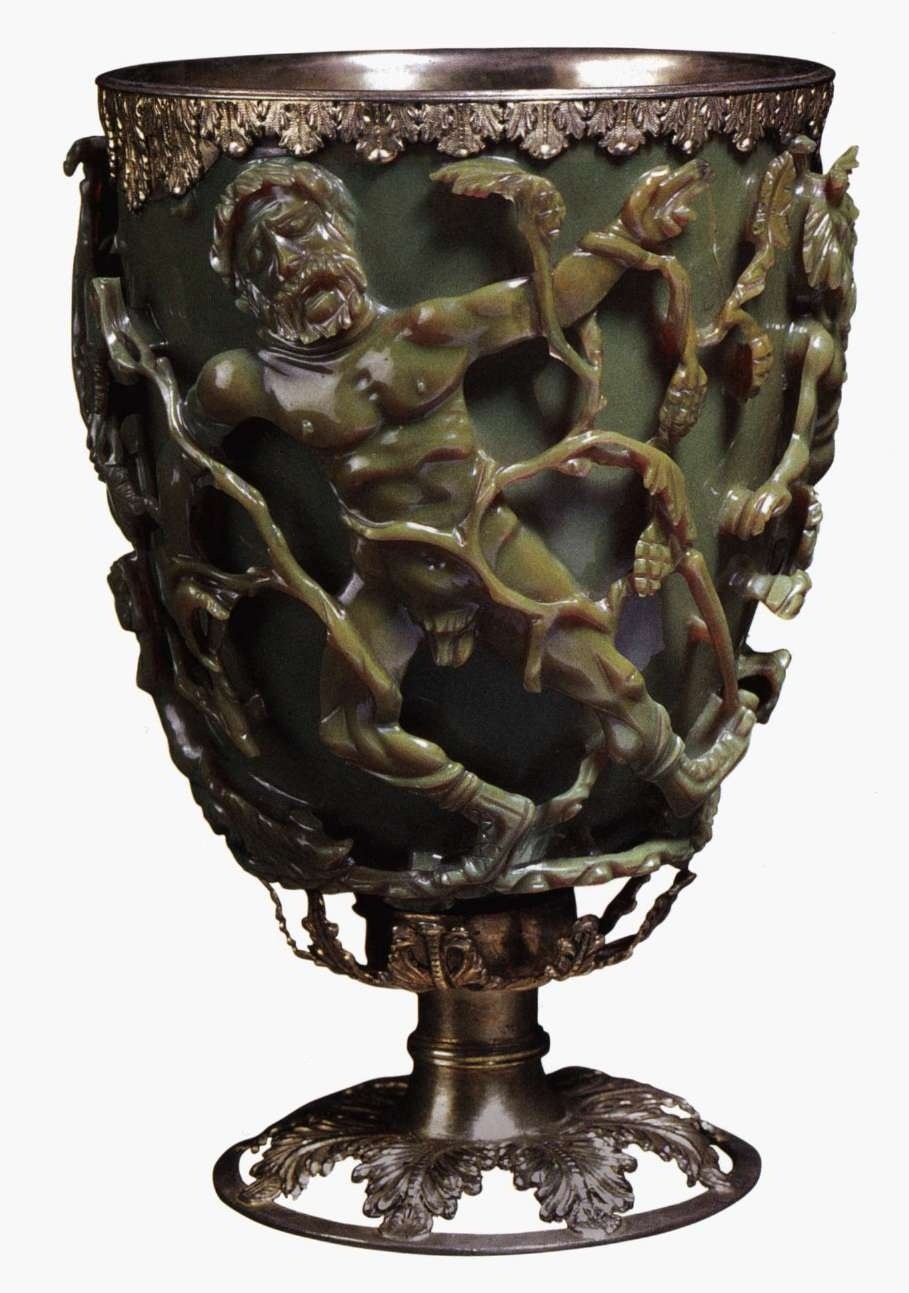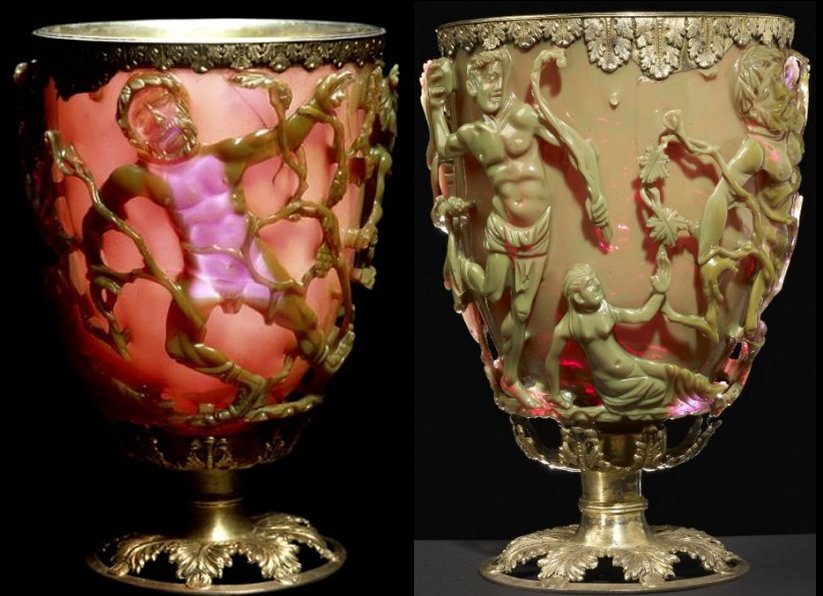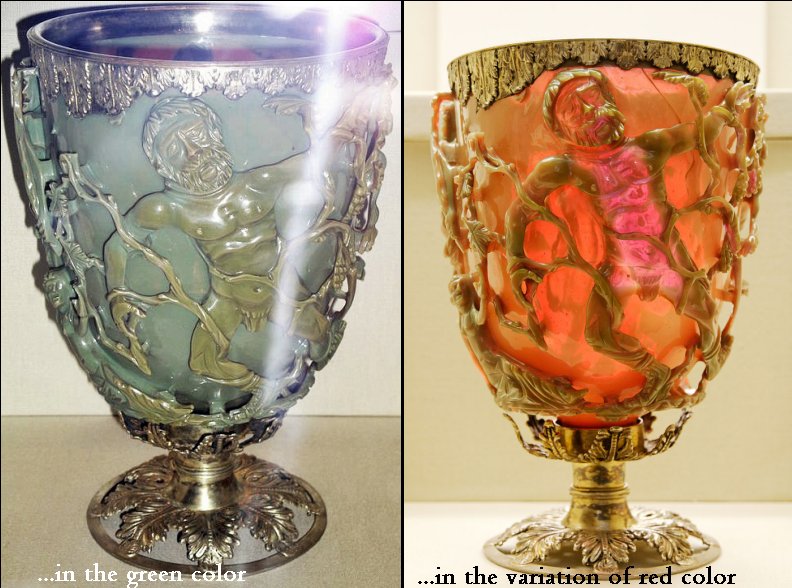The Lycurgus Cup: Fascinating Artifact That Reveals Prehistoric Knowledge Of Nanotechnology
A. Sutherland - AncientPages.com - Although nanotechnology represents a new, relatively modern concept and is related to ultrahigh precision and ultra-small sizes, the term "nano" is old. It comes from the Greek word "nanos," which means "dwarf."
This extraordinary Lycurgus cup is the only surviving complete example made from dichroic glass, which changes color when held up to the light. When light is shone through the body of the cup it turns from opaque green to a glowing translucent red. The glass contains tiny amounts of colloidal gold and silver, which give it these unusual optical properties. Image credit: British Museum
Knowledge about metallic nanoparticles has been used since ancient times, especially regarding the unusual colors in antique glass and ceramic objects. It is believed that the use of metallic nanoparticles started with the beginning of glass-making in Egypt and Mesopotamia, dating back to the fourteenth and thirteenth centuries BC.
The most remarkable example of the use of metallic nanoparticles is the Lycurgus Cup, a piece of Roman glasswork dating from the fourth century CE, showing a mythological scene depicting the legend of King Lycurgus.
"....Glass-producing techniques were highly developed, and workmanship was superb.
In the Lycurgus Cup, now housed in the British Museum, the 324 AD victory of Constantine over Licinius in Thrace was represented through the death of an enemy of Dionysius, Lycurgus, who is shown being overcome by vines...." Daniel L. Schodek, Paulo Ferreira, Michael F. Ashby write in their book "Nanomaterials, Nanotechnologies and Design."
The satyr with the rock, in the new 2014 display in the British Museum. Image credit: Johnbod - CC BY-SA 3.0
The theme of this myth - the triumph of Dionysius over Lycurgus - might have been chosen to refer to a contemporary political event, the defeat of the emperor Licinius (reigned AD 308-24) by Constantine in AD 324.
The Lycurgus Cup exhibits a color-changing property that makes its glass take on different hues depending on the light source. The changes in the colors have been a scientific mystery for a long time.
In the 1990s, researchers noticed tiny particles of silver and gold in the cup's glass, and it became clear that light played an important role when the Romans created the cup. When hit with light, electrons belonging to the metal flecks vibrated in ways that altered the color depending on the observer's position.
Researchers attempt to build the unique technology used in the artifact and apply it in the medical field. Still, they cannot do it using the original artifact, so they use a replica of the artifact, allowing them to pursue their ideas. The replica is a color-changing cup on a much smaller scale, imprinting billions of microscopic wells on a plastic plate with the same nanoparticles.
The most famous example of the use of metallic nanoparticles concerns a piece of Roman glasswork, the Lycurgus Cup, dating from the fourth century CE, showing a mythological frieze depicting the legend of King Lycurgus. British Museum, rum 41
According to the British Museum, this is the only complete "dichroic" glass example. The opaque green cup turns to a glowing translucent red when light is shone through it. The glass contains tiny amounts of colloidal gold and silver, which give it unusual optical properties.
The cup is also the only figural example of a vessel known as a 'cage-cup.' The cup was made by blowing or casting a thick glass blank.
It was cut and ground away until the figures were left in high relief. Sections of the figures are almost standing free and connected only by 'bridges' to the vessel's surface.
According to Historia Augusta", a late Roman collection of biographies of the Roman Emperors, written in Latin and possibly dated to the third and early fourth centuries, two dichroic glasses were delivered as gifts from Hadrian to his brother-in-law Servianus through a record.
Lycurgus cup, variations of color. When viewed in reflected light, as in this flash photograph, the cup's dichroic glass is green in color, whereas when viewed in transmitted light, the glass appears red. British Museum. Image credit: Johnbod - CC BY-SA 3.0
It might have been one of these. Vopiscus detailed some dichroic glasses in "The Lives of Firmus, Saturninus, Proculus and Bonosus" from the "Historia Augusta."
He refers to correspondence supposedly composed by Hadrian to his brother-in-law Servianus:
"I am giving you over some glasses, shifting colors, given to me by the temple priest, especially to you and my sister. I would like you to utilize them on feast days".
The Lycurgus cup is a fantastic artifact - proof of the very advanced skills of its manufacturer.
The result of this extreme work is a high sculpture linked to the surface of the glass with thin connections. On the Lycurgus cup, these connections are grapevines along with other figural components.
Were the ancient Romans familiar with nanotechnology? Is it one of alchemy's secrets? If not, where did this knowledge and technological skills come from? Some believe this extraordinary artifact is far older than ancient Greece or Rome.
If the Greek or Roman masters invented this nanotechnology, why are there no other examples of their skills?
Updated on March 27, 2024
Written by – A. Sutherland AncientPages.com Staff Writer
Copyright © AncientPages.com All rights reserved. This material may not be published, broadcast, rewritten or redistributed in whole or part without the express written permission of AncientPages.com
Expand for referencesReferences:
Schodek L.D., Ferreira P., Ashby M. F. "Nanomaterials, Nanotechnologies and Design"
More From Ancient Pages
-
 Mystery Of Prehistoric Gigantic Hill Figures Of England
Featured Stories | Sep 20, 2018
Mystery Of Prehistoric Gigantic Hill Figures Of England
Featured Stories | Sep 20, 2018 -
 Police Forces That Kept Order In Ancient Streets
Ancient History Facts | Jun 12, 2018
Police Forces That Kept Order In Ancient Streets
Ancient History Facts | Jun 12, 2018 -
 Superfood Of Ancient Andeans Reconstructed – What Helped To Fuel The Tiwanaku Civilization 2,500 Years?
Archaeology | Nov 30, 2021
Superfood Of Ancient Andeans Reconstructed – What Helped To Fuel The Tiwanaku Civilization 2,500 Years?
Archaeology | Nov 30, 2021 -
 Undiscovered Neanderthal Artifacts From The Ice Age Are Submerged Below The Waves Of The English Channel
Archaeology | Nov 23, 2022
Undiscovered Neanderthal Artifacts From The Ice Age Are Submerged Below The Waves Of The English Channel
Archaeology | Nov 23, 2022 -
 Caribbean Silk Cotton Tree And Its Dangerous Spirits In Myths And Legends
Featured Stories | Jan 29, 2024
Caribbean Silk Cotton Tree And Its Dangerous Spirits In Myths And Legends
Featured Stories | Jan 29, 2024 -
 Prehistoric Anomaly On The Tennessee-North Carolina Border Baffles Scientists
Featured Stories | Jul 30, 2024
Prehistoric Anomaly On The Tennessee-North Carolina Border Baffles Scientists
Featured Stories | Jul 30, 2024 -
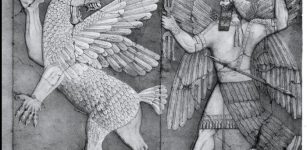 Evil God-Bird Anzu Who Stole The Tablet Of Destiny To Control Universe and Fates Of All
Featured Stories | Aug 8, 2016
Evil God-Bird Anzu Who Stole The Tablet Of Destiny To Control Universe and Fates Of All
Featured Stories | Aug 8, 2016 -
 Strange Ancient Abduction Case And Mysterious Journey To A Snake King’s Palace In A Parallel World
Ancient Mysteries | May 1, 2021
Strange Ancient Abduction Case And Mysterious Journey To A Snake King’s Palace In A Parallel World
Ancient Mysteries | May 1, 2021 -
 Kali – Hindu Goddess Of Death, Fear And Horror Who Destroys Ignorance, Evil And Establishes World Order
Featured Stories | Sep 28, 2021
Kali – Hindu Goddess Of Death, Fear And Horror Who Destroys Ignorance, Evil And Establishes World Order
Featured Stories | Sep 28, 2021 -
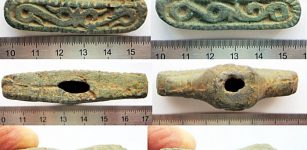 Fragments Of 100 Viking Swords Unearthed In North Estonia – Largest Find To Date
Archaeology | Oct 6, 2019
Fragments Of 100 Viking Swords Unearthed In North Estonia – Largest Find To Date
Archaeology | Oct 6, 2019 -
 On This Day In History: Ensisheim Meteorite Fell To Earth – On Nov 7, 1492
News | Nov 7, 2016
On This Day In History: Ensisheim Meteorite Fell To Earth – On Nov 7, 1492
News | Nov 7, 2016 -
 Remains Of 2,500-Year-Old Aphrodite Temple Unearthed In Turkey
Archaeology | Jan 7, 2021
Remains Of 2,500-Year-Old Aphrodite Temple Unearthed In Turkey
Archaeology | Jan 7, 2021 -
 Termessos: City Where History And Mythology Marked People’s Daily Lives
Featured Stories | Apr 4, 2025
Termessos: City Where History And Mythology Marked People’s Daily Lives
Featured Stories | Apr 4, 2025 -
 Unique Ancient Structure With Mysterious V-Shaped Carvings, Wine Press And More Discovered In The City Of David, Jerusalem
Archaeology | Jan 24, 2025
Unique Ancient Structure With Mysterious V-Shaped Carvings, Wine Press And More Discovered In The City Of David, Jerusalem
Archaeology | Jan 24, 2025 -
 How Henry VIII Accidentally Changed The Way We Write History
Featured Stories | Sep 6, 2024
How Henry VIII Accidentally Changed The Way We Write History
Featured Stories | Sep 6, 2024 -
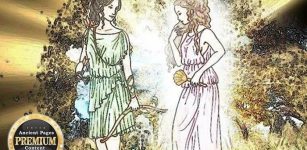 Ancient Greek Goddesses Aphrodite And Artemis – Rivalry And Conflict Over Prestige Illustrated In Hippolytus By Euripides
Featured Stories | Jun 13, 2018
Ancient Greek Goddesses Aphrodite And Artemis – Rivalry And Conflict Over Prestige Illustrated In Hippolytus By Euripides
Featured Stories | Jun 13, 2018 -
 Strange Case Of The Italian Doppelganger – A Tragedy – Part 1
Featured Stories | Oct 14, 2019
Strange Case Of The Italian Doppelganger – A Tragedy – Part 1
Featured Stories | Oct 14, 2019 -
 How Did Sargon Become The Most Powerful Ruler Of Mesopotamia?
Featured Stories | Apr 3, 2020
How Did Sargon Become The Most Powerful Ruler Of Mesopotamia?
Featured Stories | Apr 3, 2020 -
 Underwater Ancient Cypress Forest Offers Clues To The Past
Archaeology | Jun 29, 2021
Underwater Ancient Cypress Forest Offers Clues To The Past
Archaeology | Jun 29, 2021 -
 Young Boy Finds Baffling Artifacts In New Mexico Predating The Anasazi, The ‘Ancient Ones’
Featured Stories | Aug 6, 2024
Young Boy Finds Baffling Artifacts In New Mexico Predating The Anasazi, The ‘Ancient Ones’
Featured Stories | Aug 6, 2024

